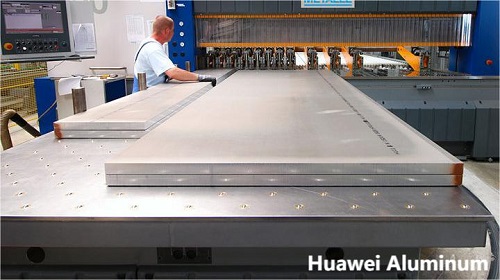What is rolled sheet aluminum?
Rolled aluminum sheet refers to an aluminum sheet manufactured by a rolling process. The rolling process involves passing a metal ingot or billet through a series of rollers to reduce its thickness and shape it into a sheet of uniform thickness. The process is used to produce aluminum sheets of specific dimensions, thickness and surface properties suitable for various applications.
 rolled aluminum sheet product
rolled aluminum sheet productProcess of rolling aluminum sheet
The process of producing rolled aluminum sheet involves several steps, starting from aluminum raw material, to the final rolled sheet with the desired thickness and dimensions. The two main methods of producing rolled aluminum sheet are hot rolling and cold rolling. Here’s an overview of the process:
1. Ingot casting preparation:
The process starts with the preparation of aluminum ingots. These ingots are usually cast from molten aluminum in a mold and allowed to solidify. The composition and alloy of the ingot is carefully controlled according to the intended application of the rolled plate.
2. Homogenization (optional):
In some cases, especially for certain aluminum alloys, the ingot may undergo a homogenization process. This helps ensure uniformity in the material’s microstructure and composition.
3. Heating (hot rolling only):
During hot rolling, steel ingots are preheated to high temperatures to make them more ductile and easier to deform.
4. Hot rolling:
During hot rolling, a preheated aluminum ingot passes through a series of rolling mills, gradually reducing its thickness while extending its length. The process involves multiple passes over the rollers with gradually decreasing gaps between them.
The hot rolling process reduces the thickness of aluminum while increasing its length and width. Materials are subjected to compressive and tensile forces during rolling.
5. Annealing (cold rolling only):
Cold rolling involves passing aluminum through rolls at or near room temperature. To prevent the material from becoming too brittle and increase its ductility, an intermediate annealing step can be introduced during cold rolling.
6. Cold rolling:
The process of cold rolling is similar to hot rolling, but at a lower temperature. Through multiple passes between the rollers with gradually decreasing gaps, the material is gradually thinned and elongated.
7. Surface treatment and coating (optional):
After rolling, aluminum sheet may be surface treated or coated to improve its surface finish, corrosion resistance, or other properties.
8. Cutting and shearing:
The rolled aluminum sheet is cut and sheared to the required size. This step ensures that the sheet is uniform in size and meets specified tolerances.
9. Quality control:
Rolled aluminum sheets undergo rigorous quality control inspections to ensure compliance with industry and customer specifications. These inspections include measurements of thickness, dimensions, mechanical properties and surface quality.
10. Packaging and delivery:
The final rolled aluminum sheet is packaged and ready for distribution to manufacturers and industries who use it for various applications such as construction, transportation, packaging, etc.
What are rolled aluminum sheet used for?
Rolled aluminum sheets are used in a wide variety of industries and applications due to their versatility, light weight, corrosion resistance, and ease of fabrication. Some common uses for rolled aluminum sheet include:
Aluminum panels are used to build:
Roof and Siding: For its durability, corrosion resistance, and aesthetics, rolled aluminum sheet is used for roofing, siding, and other architectural elements.
Wall cladding: Aluminum panels are used for exterior and interior wall cladding in commercial and residential buildings.
Curtain Wall: Rolled aluminum panels are a key component of the curtain wall system, providing structural support and aesthetic elements.
Aluminum sheet for transport:
Automotive: Due to its lightweight nature, rolled aluminum sheet is used to make body panels, hoods, doors and other parts that help improve fuel efficiency.
Aerospace: In the aerospace industry, aluminum sheet is used for aircraft structures, wings, fuselage and interior components.
Ships: Due to their corrosion resistance in marine environments, aluminum sheets are used for hulls, decks and superstructures.
Aluminum plate for packaging:
Aluminum cans: Rolled aluminum sheets are used to make beverage cans because of their light weight, barrier properties to protect the contents, and recyclability.
Foil packaging: Thin sheets of aluminum are used to make flexible packaging materials, such as the foil used to package food, pharmaceuticals, and other products.
Aluminum sheet is used in manufacturing:
Appliances: Rolled aluminum sheets are used in the production of household appliances such as refrigerators, ovens, and washing machines.
Machinery and Equipment: Aluminum sheet is used to manufacture components for various industrial machinery and equipment.
Aluminum sheet for electrical and electronics:
Conductor: Aluminum sheets are used as electrical conductors for power transmission and distribution due to their good electrical conductivity and lightweight properties.
Electronic Components: Aluminum sheet is used to make electronic housings, housings and heat sinks.
Aluminum panels for signage and displays:
Outdoor Signage: Due to its weather resistance and customizable properties, rolled aluminum sheet is commonly used for outdoor signage and displays.
Aluminum sheet for cookware and kitchen accessories:
Pots and Pans: Aluminum sheet is used in the production of cookware due to its excellent thermal conductivity and light weight properties.
Baking pans: Baking pans and trays are usually made of aluminum because it distributes heat evenly.
The versatility of rolled aluminum sheet, combined with its corrosion resistance, formability, and lightweight properties, make it the first choice for a wide range of applications across industries.
